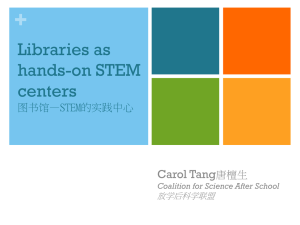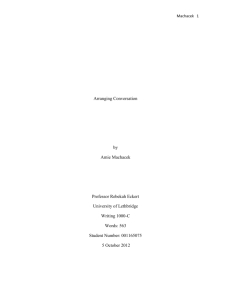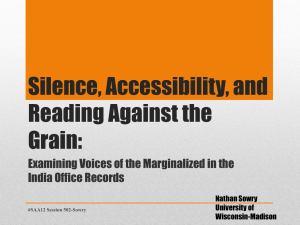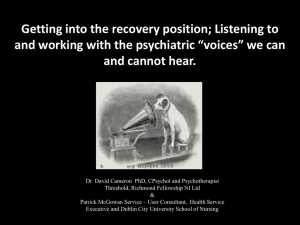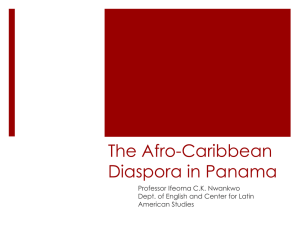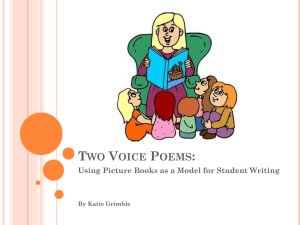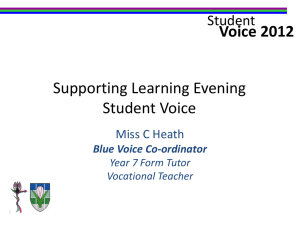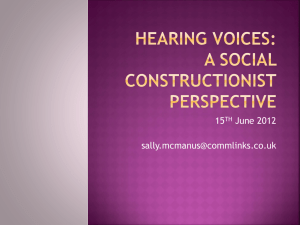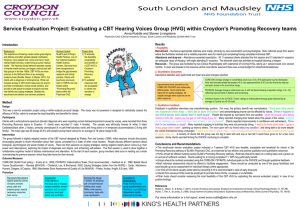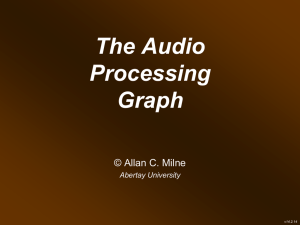The problems and potential of giving voice to children
advertisement
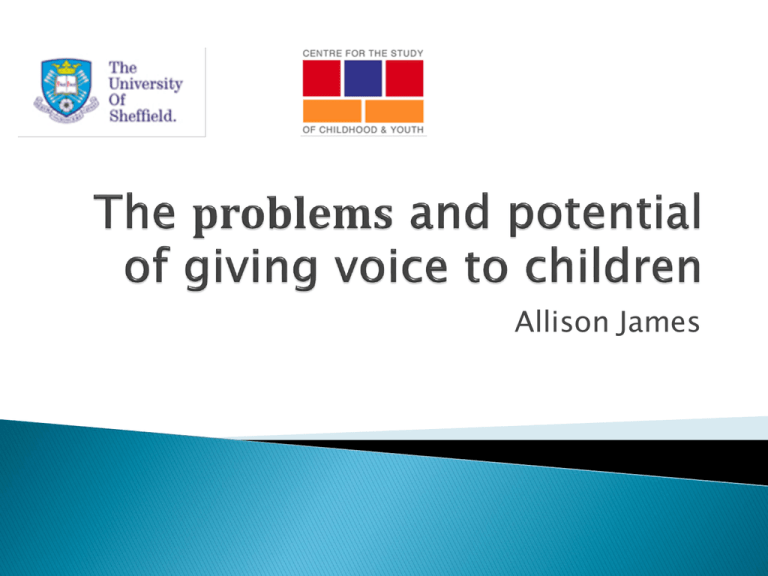
Allison James New mantra for policy & practice since UNCRC 1989 Listening to children about matters that concerns them Children's wishes and feelings to be sought out “Children’s voices” seen as symbol of democratic society Yet… articulate few often stand for the many exploitation of poor and oppressed – use of children as witnesses of hunger seen as authentic, unmediated voices symbolic of innocence of children Inclusion of children's views still often tokenistic voices still often ignored & dismissed in practice ‘new paradigm’ 1970s onwards Hardman (1973); James and Prout (1990) Children as social actors Children as informants about own lives Children’s standpoint & perspective ◦ an account of society from the point where children stand – that is, from a children’s standpoint – is in principle just as conceivable as any of the theoretical accounts of more conventional ‘adult sociologies’ (Alanen 1992:109). 1990s onwards New methods for research and accessing children’s views ◦ children’s voices/ perspectives appear in research accounts, speaking about the things that concern them as children. ◦ growth of participatory research methods to access children’s views Why is it that given the political rhetoric surrounding the commitment to hearing “children’s voices” and, apparently, now having the theoretical and methodological means to access them, little of what children say seems to get heard outside of the academy (Roberts 2000) ? Epistemological break with ideas of children's incompetence to speak BUT ◦ No longer sufficient simply to present children’s voices as apt illustrations ◦ Childhood studies has now to engage more directly with core issues of social theory & policy & practice ◦ must clearly identify unique contribution to understanding social world that children’s perspectives offer – i.e. why children's voices matter ◦ need to recognise potential of political shift - parallel shifts in feminism (1) Authenticity & representation ◦ ◦ ◦ ◦ Who is representing children? How are children's voices being represented? For what purposes? What role(s) do children's voices carry in research? ( 2) Issues of diversity ◦ “children’s voices” and “voices of children” gloss differences between children ◦ UNCRC – best interests of “the child” (Article 12) (3) Issues of participation ◦ Research roles – research “on” or “with” children? How far are / can children be included in research? (4) Issues of interpretation Can adult researchers see the world from “ the native’s [children's} point of view” (Geertz 1983) ? (5) Children as researchers? Does using children as researchers necessarily lead to: greater authenticity? Does it overcome power differences in the research relationship? Need to interrogate authenticity and representation ◦ “the voice of the child” is not unimpeachable Children’s voices in accounts NOT authentic ◦ Voices chosen , selected by author Need to avoid “ethnographic ventriloquism” (Geertz 1983)i.e. claiming to speak for children ‘ the ethnographer …in the end assumes an executive , editorial position’ (Clifford 1988:51). Need to recognise that “the voice of the child” is not universal ◦ there is no such thing as ‘the child’ need to avoid text positivism i.e. assuming that “ what children say” applies to all children “Children’s voices” are always glossed by the author ◦ ‘quotations are always staged by the quoter and tend to serve merely as examples of confirming testimonies’ (Clifford 1988:50) Need to challenge routine “quoting” voices in text ◦ adding decoration in claim to authenticity ◦ tokenistic practices Participatory research methods do allow children’s voices to be heard ◦ ◦ ◦ ◦ Fun for children to do allows abstract ideas to become more concrete Mediates research relationship Draws on children's own skills BUT ◦ Can become end in their own sake! ◦ Proliferation of methods often just a proliferation – not triangulation ◦ Children can become over researched and over whelmed Aim to make children’s voices more authentic & overcome other problems BUT ◦ ‘the reasons why a child or a young person should choose to participate in research are clearer in some studies than others…we cannot take it for granted that participation in research and the development of increasingly sophisticated research methods to facilitate children’s participation is necessarily always in their interests’ ( Roberts 2000:238). ◦ Can be potentially as exploitative as other forms of research ◦ Can lead to a tension between research and advocacy roles ◦ Can limit aims of research and research questions to “children's issues”, rather than asking children about other m,ore global concerns Research has revealed children's engagement with adult world & need to listen to children ◦ (e.g. children’s views of parental divorce Smart, Neale and Wade 2001) ◦ (e.g. implementation of Childrend ACT 1989 -children's wishes and feelings & adults’ idea of “best interests” (James, James and McNamee 2004) Child-centred research has assisted with promotion of children's rights & their local implementation ◦ ( e.g. children as health educations Onyango-Ouma 2001) ◦ Children’s perspectives on child labour (Boyden, Ling and Myers 1998) Recognition of social construction of childhood has enabled diversity to be explored ◦ (e.g. culturally appropriate interventions Woodhead 1996) ◦ ( e.g. children's views on gender and race in the classroom (Connolly 1998; 2004) Childhood studies achieved a great deal Poised for development in future Voices important but also need to explore structural issues Cultural politics of children's voices can explore relationship between: ◦ Childhood as a social space ◦ Childhood as a generational category ◦ Child as individual
